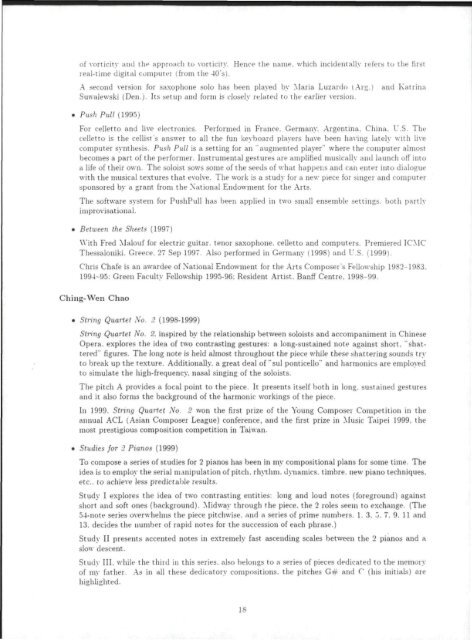Download - CCRMA - Stanford University
Download - CCRMA - Stanford University
Download - CCRMA - Stanford University
You also want an ePaper? Increase the reach of your titles
YUMPU automatically turns print PDFs into web optimized ePapers that Google loves.
of vorticity and the approach to vorticity. Hence the name, which incidentally refers to the first<br />
real-time digital computet (from the 40s).<br />
A second version for saxophone solo has been played by Maria Luzardo (Arg.) and Katrina<br />
Suwalewski (Den.). Its setup and form is closely related to the earlier version.<br />
• Push Pull (1995)<br />
For cellerto and live electronics. Performed in France. Germany. Argentina. China. U.S. The<br />
celletto is the cellist's answer to all the fun keyboard players have been having lately with live<br />
computer synthesis. Push Pull is a setting for an "augmented player" where the computer almost<br />
becomes a part of the performer. Instrumental gestures are amplified musically and iaunch off into<br />
a life of their own. The soloist sows some of the seeds of what happens and can enter into dialogue<br />
with the musical textures that evolve. The work is a study for a new piece for singer and computer<br />
sponsored by a grant from the National Endowment for the Arts.<br />
The software system for PushPull has been applied in two small ensemble settings, both partlv<br />
improvisational.<br />
• Between the Sheets (1997)<br />
With Fred Malouf for electric guitar, tenor saxophone, celletto and computers. Premiered ICMC<br />
Thessaloniki. Greece. 27 Sep 1997. Also performed in Germany (1998) and U.S. (1999).<br />
Chris Chafe is an awardee of National Endowment for the Arts Composer's Fellowship 1982-1983.<br />
1994-95: Green Faculty Fellowship 1995-96: Resident Artist. Banff Centre. 1998-99.<br />
Ching-Wen Chao<br />
• String Quartet No. 2 (1998-1999)<br />
String Quartet No. 2. inspired by the relationship between soloists and accompaniment in Chinese<br />
Opera, explores the idea of two contrasting gestures: a long-sustained note against short, "shattered"<br />
figures. The long note is held almost throughout the piece while these shattering sounds try<br />
to break up the texture. Additionally, a great deal of "sul ponticello" and harmonics are employed<br />
to simulate the high-frequency, nasal singing of the soloists.<br />
The pitch A provides a focal point to the piece. It presents itself both in long, sustained gestures<br />
and it also forms the background of the harmonic workings of the piece.<br />
In 1999. String Quartet No. 2 won the first prize of the Young Composer Competition in the<br />
annual ACL (Asian Composer League) conference, and the first prize in Music Taipei 1999, the<br />
most prestigious composition competition in Taiwan.<br />
• Studies for 2 Pianos (1999)<br />
To compose a series of studies for 2 pianos has been in my compositional plans for some time. The<br />
idea is to employ the serial manipulation of pitch, rhythm, dynamics, timbre, new piano techniques,<br />
etc.. to achieve less predictable results.<br />
Study I explores the idea of two contrasting entities: long and loud notes (foreground) against<br />
short and soft ones (background). Midway through the piece, the 2 roles seem to exchange. (The<br />
•54-note series overwhelms the piece pitchwise. and a series of prime numbers. 1. 3. J. 7. 9. 11 and<br />
13. decides the number of rapid notes for the succession of each phrase.)<br />
Study II presents accented notes in extremely fast ascending scales between the 2 pianos and a<br />
slow descent.<br />
Study III. while the third in this series, also belongs to a series of pieces dedicated to the memory<br />
of my father. As in all these dedicatory compositions, the pitches G# and C (his initials) are<br />
highlighted.<br />
18

















